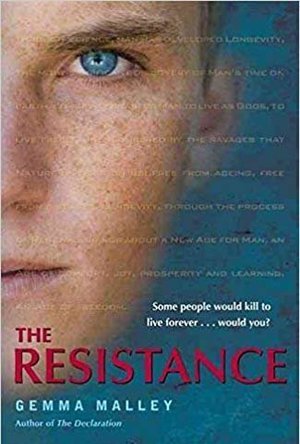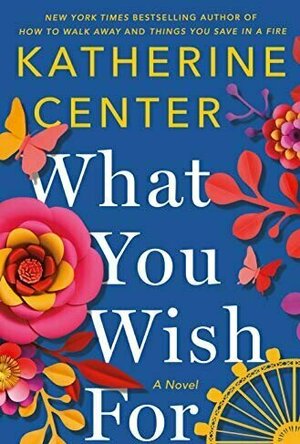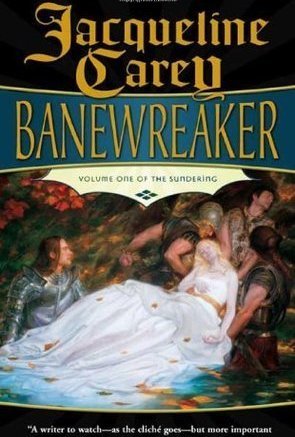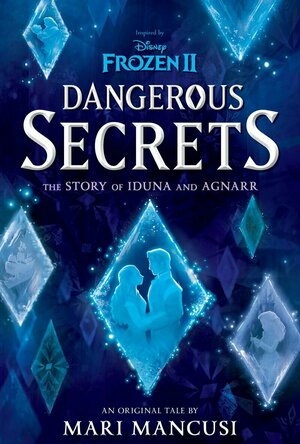
The Lucky Few: Finding God's Best in the Most Unlikely Places
Heather Avis and Lysa TerKeurst
Book
These are the faces that call me "mom," the three children who made me a mother. When I started my...
Eleanor Luhar (47 KP) rated The Returners in Books
Jun 24, 2019
Anyway, the review.
It's a good book. honestly, the opening paragraph of this review sums the book up quite well - it's good, but not overly memorable. When you read it, you often think, "this is good" or "cool" or whatever, but a few months later you'll forget all about it. At least, that's how I felt.
Gemma Malley is an author I used to love when I was in my preteens, and I'm not sure if that's why her books feel very adolescent to me, or if it's because they actually are. Basically, I feel too old for them now. The protagonists are usually "cool" mid-teens, who the reader is supposed to look up to in some way. But I'm older than most characters and actually find their attitudes a bit pathetic and petty.
The story was good but I felt like there were a few loopholes, honestly. The idea of the "Returners" is interesting but not developed enough - who actually 'controls' them? Where did they come from? What is their real purpose? I felt like their purpose was a bit wishy-washy. Douglas's refusal to change his attitude because it "isn't their role" or whatever just sounded a bit... lame. Like a cop-out, I guess. I really would've liked to know more about the Returners and why they actually exist.
It's only short and this may contribute to it feeling quite young, but it is well written and really enjoyable to read. Will is almost an anti-hero, and as the reader I both loved and hated him. His thoughts and attitudes were quite sporadic and it was sometimes hard to keep up, but that may have been the intention. I did like how we learned things at the same time as Will - we followed him through his own story. It was also really interesting how Will decided to handle the life he'd been forced into.
4 stars.

Mortgage Calculator Plus
Finance and Business
App
Mortgage Calculator Plus is the easiest to use Mortgage Calculator available on the App Store. ***...

BlogTouch (for Blogspot Blogger)
Lifestyle and Social Networking
App
The #1 Blogger editor for your iPhone, iPod, iPad and Mac! BlogTouch is the most powerful...

BlogTouch Pro (for Blogspot Blogger)
Lifestyle and Social Networking
App
The #1 Blogger editor for your iPhone, iPod, iPad and Mac! BlogTouch is the most powerful...
Kristy H (1252 KP) rated What You Wish For in Books
Aug 6, 2020
Maybe it's because I'm the child of educators, but I just kept shaking my head at the idea of a principal who could come in and unilaterally make decisions without any resistance. It made it impossible for me to focus on the rest of the story. Apparently Duncan is hired by the school founders' son-in-law--essentially a school board of one. What private school has one person on their board? What sort of private school has parents who just quietly allow someone to paint the halls gray and put bars on the windows??! None of this made any sense to me. All the resistance came down to the teachers?? I've seen parents riot over far less.
I couldn't handle it--could you tell? I also couldn't handle Sam for most of the book. I just get frustrated with Center's heroines. Sam was so whiny about nearly everything. She was more than happy to judge everyone else, yet completely resistant to owning her own life, making any changes, and opening up. Ugh. I wanted to shake her sometimes.
The book was very slow to start. Much rehashing of Sam's own problems, Duncan's arrival and the fact that--can you believe it--he is different than he was before. Hey, did you know Duncan used to be cool and funny, but now he's not?! I didn't! Oh wait, let me tell you again 15 times. Also, let's go into the fact that Sam has some issues and can never ever love again. Did I mention ever?
Also, later, without giving too much away, we completely gloss over how serious PTSD is and whitewash over the severity of things like depression, because focusing on happy things will just take away those issues completely, right? Also most plot points are telegraphed a mile away.
Sigh, I'm probably being too harsh here. The book gets a bit better as things go on. And there's a really cute kid whom I enjoyed. But still. Repetitive, predictable, and not the best at presenting mental health issues. 2.5 stars, rounding to 3 here.
Mandy and G.D. Burkhead (26 KP) rated Banewreaker in Books
May 20, 2018
Banewreaker, the first book in Jacqueline Carey’s two-part volume The Sundering, will probably not change any opinions in this respect, then, as it’s sweeping high fantasy to the core. This, as it turns out, is both its greatest strength and its greatest weakness.
There are some reviews out there that laud Banewreaker as a masterful examination of subjective viewpoints in an epic fantasy turned into a human tragedy by a simple change of perspective. And they are absolutely correct.
There are other reviews, however, that call the book out as a heap of all of the stalest fantasy clichés piled one atop the other in a confusing and pretentious jumble with a shellacking of purple prose for good measure. And they are also absolutely correct.
Let me explain.
For starters, it would be inaccurate to say that this story is full of clichés. This story is clichés. This story is every familiar and used-up trope you would expect from a high fantasy, all of those details that have been done to death in thousands of other versions until almost nothing that happens seems original anymore.
This is what’s going to turn off a lot of people. But the thing is, Banewreaker has to be this way. It wants the reader to look at all of the things that they’ve come to expect from a fantasy epic and then, by shifting the narrative focus, realize that all of these beloved tropes are actually, when you think about it, tragic as hell.
In other words, it’s Lord of the Rings from Sauron’s point of view.
It’s not a riff, though. It’s not goofy like most of the stuff I go in for. It takes its subject just as seriously as the stories that it’s mirroring, and this is what makes the whole story ultimately so gripping and so moving.
The story starts out like many stories of this magnitude, with exposition stretching back to the Dawn of This Particular Creation. In this case, we have a protogenos world god named Uru-Alat who died and gave rise to seven smaller godlike beings called Shapers. First comes Haomane, who becomes the Lord of Thought and sets himself up as head honcho for this ensuing pantheon. Second is Arahila, the Basically a Love Goddess; and third is Satoris, whose purview was “the quickening of the flesh,” which is high fantasy speak for sexy times. Four more Shapers come after this who, for the sake of brevity, we’ll be glossing over.
To summarize the important godly exposition, the Seven Shapers set about shaping the world to the surprise of no one. Haomane creates elves (here called Ellyl, but if you’ve ever even looked at a fantasy, you know that they’re the elves here), Arahila creates humans, and Satoris doesn’t create anything because he’s busy hanging out with dragons and learning their wisdom. Satoris grants his fleshy quickening to the humans but not the elves, because Haomane didn’t want his elves to do that. Then Haomane decides he doesn’t want the humans to do that either, but Satoris refuses to take the gift away again. Conflict escalates, god wars ensue, and the world splits into two continents, with Satoris ostracized from his brethren on one and the remaining Shapers on the other. By the time the dust has settled, Satoris is scarred and burned pitch black, living in a mostly dead land thanks to Haomane’s wrath, but with a dagger in his possession that is the only weapon capable of killing any of the Shapers.
The story itself picks up thousands of years later, with Satoris as the Satan/Sauron stand-in living in a forbidding land surrounded by classically evil things like trolls, giant spiders, and insane people. Since Haomane is the head god, the rest of the world believes Satoris to be a terrible figure of evil and betrayal, while Satoris’s few allies know him as a pitiable and misunderstood figure who only ever wanted to honor his word and do right by his own sense of morality rather than the dictates of his elder brother god king.
From here the plot becomes the typical Army of Good vs. Army of Evil adventure, but with the protagonistic focus on Satoris and his allies. His trolls we see not as a mindless horde but as a simple, honorable people who happily serve their lord because he happily serves them right back. The mad individuals inhabiting his fortress are castaways from normal society with nowhere else to go. And the giant spiders just happen to live there and be bigger than normal, with no sinister intentions beyond that.
And just like that, by actually showing us the home life of the ultimate in evil fantasy tropes, we see how easily one side’s view of evil is another’s view of good. In doing so, Banewreaker becomes perhaps the first sweeping fantasy epic with no real bad guy, just two sides of an unfortunate conflict. Both sides have their likeable characters, both sides seem from their view to be in the right, and pretty soon you, as the reader, will stop cheering for either one, because whenever one person that you like succeeds it means that another person whom you also like is failing.
In fact, the closest thing that this story has to a clearly-labeled “evil” character is the sorceress Lilias, and even then, she’s not evil so much as a woman who has done some bad things for completely understandable reasons. Lilias, in fact, is one of the most pitiful characters in this whole saga of pitiable characters, with her fears and attachments closely mirroring those of most readers, only amplified by her immortality and magical powers. She is afraid of dying. She wants to be more in the grand scheme of things than just another man’s wife or another country’s momentary ruler, both of which would just be tiny moments in a long history. She likes her youth. She likes having pretty things and pretty people around her. And from her interactions with her dragon mentor and apparently only friend, Calandor, we see that she is also capable of intense affection and even love just as she is capable of indulging in self-centered self-interest that, if not particularly a good trait, is also one that she is not alone in possessing.
Banewreaker, then, is a story with a large cast of characters but very few actual heroes or innocents as well as very few outright villains, which is exactly what it sets out to be. Those who love it and those who hate it both seem to blame this quality in particular for their feelings. The biggest complaint leveled against it (that I have read, anyway) is that the people we should be rooting for do not deserve our sympathy, while the people we should be rooting against are more misguided and unwilling to see things in another light than deserving of our scorn.
This is true. But if it’s a flaw, it’s an intentional one. And if it makes you feel like you shouldn’t be cheering for either side at all in this conflict, that’s the point. This is a story of clichés, yes, but it has something that it needs to say about these clichés and, in doing so, about the subjective and impossibly nebulous quality of morality in general.
In short, here again is another fantasy story about the Forces of Good wiping out an entire nation dedicated to their “evil” enemy. And as the story points out, even if you believe in that cause, you’re still wiping out an entire nation of people. No way is there not a downside to that. Seeing things in a black-and-white morality just means crushing a whole lot of important shades of gray underfoot.
Whether or not you like Banewreaker, then, depends in large part upon how much you realize that Carey as an author is being self-aware. As someone who read and still hasn’t stopped being awed over her Kushiel series, I can’t claim complete objectivity in this area, because I came to Banewreaker already in love with her. I can say, however, that unless you have an intense and searing aversion to ornate and sweeping style, this book is worth any fantasy-lover’s time – especially if you’ve ever felt a pang of empathy for all of the poor villainous mooks that fantasy heroes tend to mow down without a thought because they were the wrong kind of ugly.
Lottie disney bookworm (1056 KP) rated Frozen 2: Dangerous Secrets: The Story of Iduna and Agnarr in Books
Dec 29, 2020
The 2019 film undoubtedly revealed some of these secrets, such as Iduna being Northuldra and saving Agnarr as a child as well as the two of them venturing to Ahtohallan to find the answers behind Elsa’s powers. Unfortunately, thanks to the film, we also know that they never completed their journey.
Cue Mari Mancusi who expertly bring the monarchs back to life through her writing and forms these little-known characters into best friends, young lovers and torn parents, always just trying to do the next right thing.
The back stories of Agnarr and Iduna are nothing short of brilliant: the reader meets both characters in the Enchanted Forest on the fateful day of the dam celebration and we experience the wonder of both worlds colliding, along with the following danger and confusion from a first-person perspective.
I thoroughly appreciated how Mari Mancusi didn’t have to explain what had happened between the Arendellian forces and the Northuldra: Mancusi knows that the reader already knows the true turn of events from the movie. All throughout Dangerous Secrets this “inside knowledge” is used beautifully: allowing us to experience events as our protagonists do, but without diluting the tension and excitement with explanations.
The reader grows up alongside the future King and Queen, seeing their friendship blossom and experiencing their respective heartbreaks and secrets. The Northuldra are widely believed to be enemies of Arendelle due to the King’s death and the rumours surrounding it. Iduna’s hardship of hiding her true identity is matched only by her grief of losing the only family she has ever known. Similarly, Agnarr has lost a father, his best friend General Matthias and now has to learn how to be a King. Even when they find solace in their friendship and the later romance that this grows into, Iduna is not royalty: their love is doomed from the start…isn’t it?
Regular readers of my reviews will know I loved Jen Calonita’s “Let it Go” but felt that towards the end the writing emulated the movie verbatim in places. I found Kamilla Benko’s “Forest of Shadows” interesting and unique but ultimately it tried too hard to insert different elements into the Frozen universe that we know and love.
In my opinion, Dangerous Secrets contains none of these criticisms.
Elements of the movie are included, of course they are! Agnarr and Iduna’s reading tree is taken straight out of Elsa’s/Ahtohallan’s ice memories; Oaken’s trading post and sauna is briefly mentioned as a rest stop during one of the couple’s adventures and the wonder of chocolate is something Elsa and Anna definitely inherited from their parents!
The difference with this novel is that any references to the movie are easter eggs: elements that we love to spot; they are not brash and in-your-face; they are subtle and add to the story rather than creating it entirely. For example, I loved the inclusion of Grand-Pabbie and the trolls. I also suspect we may have met Kristoff’s mother – perhaps opening the door to another book from Mari Mancusi?
Of course, Dangerous Secrets can only end with the fateful voyage made by the royal couple and, true to form, this made me cry my little heart out. I know from the author’s note that Mari Mancusi is a mother herself but I feel that I would have known this anyway through the sheer heartbreak she portrays through Iduna, and later Agnarr. From their first discovery of Elsa’s powers; to Anna’s accident; to acknowledging that they were endangering Elsa by asking her to “conceal, don’t feel” right up until the couple’s realisation that they will never see their daughters again: the writing is powerful, hard-hitting and, with Ahtohallan’s last gift, stunningly beautiful.
This is a five-star glimpse into the King and Queen of Arendelle and a must-read for any fan of Frozen.
Will Mancusi reveal the secret of the ice-gatherer woman’s identity next?
Only Ahtohallan knows.

iSpeedCam Canada (SpeedCam Detector with GPS Tracking)
Navigation and Utilities
App
Welcome to iSpeedCam - the most advanced Traffic Enforcement Camera warning system for the iPhone...

i SpeedCam Europe (Speed Camera Detector with GPS Tracking)
Navigation and Utilities
App
Welcome to iSpeedCam - the most advanced Traffic Enforcement Camera warning system for the iPhone...



